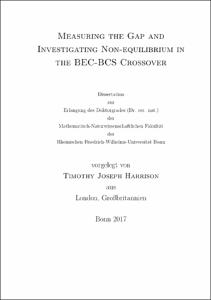Harrison, Timothy Joseph: Measuring the Gap and Investigating Non-equilibrium in the BEC-BCS Crossover. - Bonn, 2017. - Dissertation, Rheinische Friedrich-Wilhelms-Universität Bonn.
Online-Ausgabe in bonndoc: https://nbn-resolving.org/urn:nbn:de:hbz:5n-48182
Online-Ausgabe in bonndoc: https://nbn-resolving.org/urn:nbn:de:hbz:5n-48182
@phdthesis{handle:20.500.11811/7248,
urn: https://nbn-resolving.org/urn:nbn:de:hbz:5n-48182,
author = {{Timothy Joseph Harrison}},
title = {Measuring the Gap and Investigating Non-equilibrium in the BEC-BCS Crossover},
school = {Rheinische Friedrich-Wilhelms-Universität Bonn},
year = 2017,
month = sep,
note = {This thesis presents a new Bose-Fermi mixture quantum gas experiment that has been used to measure the gap over the BEC-BCS crossover and investigate the non-equilibrium dynamics of a superfluid in response to a quench of the interaction strength. Bosonic 23Na sympathetically cools fermionic 6Li in an optically plugged magnetic trap before transferring the atoms to an optical dipole trap. The broad Feshbach resonance of 6Li is then used to tune the scattering length and by entering the strongly interacting regime, very efficient evaporation can be performed. Bose-Einstein condensation of molecules with over 5×1066Li atoms per spin state has been observed and temperatures T/TF=0.07±0.02 have been achieved. The broad Feshbach resonance of 6Li can then be used to bring the atoms into the BCS regime, where long range Cooper pairs of opposite spin and momentum form a superfluid state, or into the universality regime, where the scattering length diverges and the system obeys universal laws.
A technique was developed whereby the population of one component of the superfluid was continuously modulated with a specific frequency. Theoretical studies show that this excitation couples to the amplitude/Higgs mode of the superfluid order parameter, which should have a resonance frequency at twice the gap value. By measuring the response of the condensate fraction at various modulation frequencies, a measure of the gap in the BEC-BCS crossover could be extracted. The measured gap value was found to be in agreement with the mean-field theory calculations and quantum Monte Carlo simulations.
Extending the same method, it was possible to rapidly change one of the components of a superfluid to a different third component. The inversion was performed in less than 50μm, faster than the dynamical gap time and quasiparticle relaxation time. This provides an excellent realization of the fast quenches of the interaction strength that have been intensely investigated theoretically. By quenching a strongly interacting superfluid to much weaker interactions, the decay of the order parameter was studied. During these non-equilibrium dynamics, evidence of a revival of the order parameter has been observed at longer time scales for weak quenches. Additionally, a weakly interacting normal mixture above the critical temperature can be quenched to interaction strengths where, in equilibrium, a superfluid should be present. The emergence of the order parameter was measured as a function of time and was found to be faster for weak quenches into the BCS regime than for larger quenches into unitarity.},
url = {https://hdl.handle.net/20.500.11811/7248}
}
urn: https://nbn-resolving.org/urn:nbn:de:hbz:5n-48182,
author = {{Timothy Joseph Harrison}},
title = {Measuring the Gap and Investigating Non-equilibrium in the BEC-BCS Crossover},
school = {Rheinische Friedrich-Wilhelms-Universität Bonn},
year = 2017,
month = sep,
note = {This thesis presents a new Bose-Fermi mixture quantum gas experiment that has been used to measure the gap over the BEC-BCS crossover and investigate the non-equilibrium dynamics of a superfluid in response to a quench of the interaction strength. Bosonic 23Na sympathetically cools fermionic 6Li in an optically plugged magnetic trap before transferring the atoms to an optical dipole trap. The broad Feshbach resonance of 6Li is then used to tune the scattering length and by entering the strongly interacting regime, very efficient evaporation can be performed. Bose-Einstein condensation of molecules with over 5×1066Li atoms per spin state has been observed and temperatures T/TF=0.07±0.02 have been achieved. The broad Feshbach resonance of 6Li can then be used to bring the atoms into the BCS regime, where long range Cooper pairs of opposite spin and momentum form a superfluid state, or into the universality regime, where the scattering length diverges and the system obeys universal laws.
A technique was developed whereby the population of one component of the superfluid was continuously modulated with a specific frequency. Theoretical studies show that this excitation couples to the amplitude/Higgs mode of the superfluid order parameter, which should have a resonance frequency at twice the gap value. By measuring the response of the condensate fraction at various modulation frequencies, a measure of the gap in the BEC-BCS crossover could be extracted. The measured gap value was found to be in agreement with the mean-field theory calculations and quantum Monte Carlo simulations.
Extending the same method, it was possible to rapidly change one of the components of a superfluid to a different third component. The inversion was performed in less than 50μm, faster than the dynamical gap time and quasiparticle relaxation time. This provides an excellent realization of the fast quenches of the interaction strength that have been intensely investigated theoretically. By quenching a strongly interacting superfluid to much weaker interactions, the decay of the order parameter was studied. During these non-equilibrium dynamics, evidence of a revival of the order parameter has been observed at longer time scales for weak quenches. Additionally, a weakly interacting normal mixture above the critical temperature can be quenched to interaction strengths where, in equilibrium, a superfluid should be present. The emergence of the order parameter was measured as a function of time and was found to be faster for weak quenches into the BCS regime than for larger quenches into unitarity.},
url = {https://hdl.handle.net/20.500.11811/7248}
}






